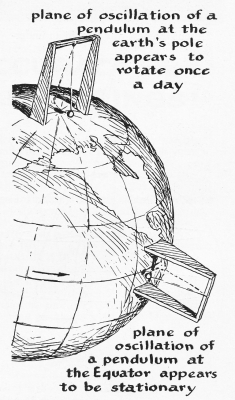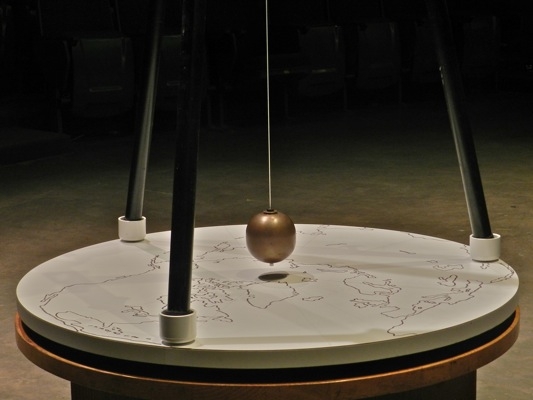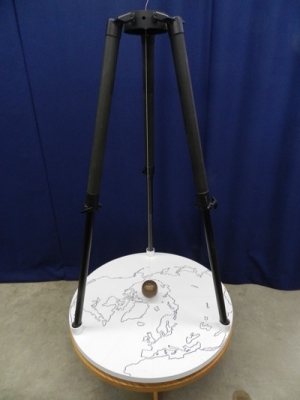What it shows:
A "working model" of a Foucault pendulum to show how its oscillations appear to change due to the rotation of "Earth" below it.
How it works:
The pendulum consists of 9-cm diameter brass ball suspended from a sturdy tripod which, in turn, sits on a heavy 3-ft diameter wooden disk. The disk represents the Earth with a projection of the northern hemisphere drawn on it. The suspension point of the pendulum is positioned over the North Pole. The entire apparatus sits on a ring bearing and the disk (Earth) can be rotated slowly by hand. While the plane of the pendulum oscillations remains fixed, one can see that in the Earth's frame of reference, the pendulum
appears to rotate.
 |
|

Setting it up:
The entire assembly sits on a 3-ft diameter table. Wrap a string around the middle of the ball. Pull the ball aside and tie the string to one of the tripod legs. When all movement has ceased, the ball is released by burning the string. Video projection will make the rotation more obvious to the entire lecture hall.
Comments:
The drawing is from C.L. Stong's Amateur Scientist "How to make a pendulum that will demonstrate the rotation of the earth," Scientific American 198, 115-124 (June 1958).
The proof of a rotating Earth was performed by Jean Leon Foucault in 1851. He suspended a 67m long pendulum from the dome of the Pantheon, Paris. The canon ball bob etched a trail in the sand below it as it swung, recording a rotation speed of 11° 15' per hour for that latitude.
References:
1. J. Priest and M. Pechan, "The driving mechanism for a Foucault pendulum (revisited)," Am. J. Phys. 76(2), 188 (2008).
2. H. H. Gottlieb, "A Short Foucault Pendulum For Corridor Display," The Physics Teacher, 421-423, (Sept. 1981).
3. W.A. Hilton, "The Foucault pendulum: A corridor demonstration," Am. J. Phys. 46(4), 436-438 (1978)
4. H. Kruglak, L. Oppliger, R. Pittet, and S. Steele, "A short Foucault pendulum for a hallway exhibit," Am. J. Phys. 46(4), 438-440 (1978)
5. R. W. Sinnott 1980 Sky and Telescope, Oct. 1980, 330-332
6. C. L. Strong 1958 Scientific American, June, 1958, 115-124
